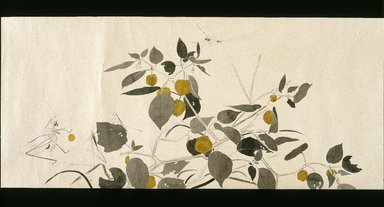
Artist:Kawakami Ryoka
Medium: Ink, opaque watercolors and possibly lacquer on wove paper decorated with mica
Geograhical Locations:
Dates:ca. 1918
Dimensions: 8 7/16 x 206 in. (21.4 x 523.2 cm)
Collections:
Accession Number: 1993.4
Image: 1993.4_detail01_IMLS_SL2.jpg,
Catalogue Description: Handscroll depicting insects and frogs engaged in humorous or unusual activities, the handscroll combines skillful brushwork in ink with exquisite renderings of floral designs and delicate paper decoration. Accompanying the amusing images are inscriptions which draw from a wide range of sources including Henry Walden Thoreau (1817-1862) and Walt Whitman (1819-1892). The subject matter may be regarded as a continuation of the tradition associated with the satirical representations observed in the well-known Heian Period handscroll, "Choju Giga (Anumal Caricatures)," a fragment of which is presently on long-term loan (L55.12) to the Brooklyn Museum of Art. The lacquer detailing is also reminiscent of the 18th century individualist Itoh Jakuchu who often used insects and flowers made to parody of Buddhist subjects. Stylistic reference are made to other painting traditions and serve to make the handscroll interesting from art historian perspective. The recent research of Japanese scholar, Tanaka Atsushi (Bunkazai Ken Kyucho) has focused new attention on the artist. Born in Niigata prefecture, Kawakami's career as artist was centered in Tokyo; his last years were spent in Nakano, on the outskirts of Tokyo. The surviving eighteen works by the artist are primarily oil paintings of subjects from nature painted in a western-influenced post-impressionist style, most of which are recorded in a 1932 retrospective exhibition catalog. The BMA handscroll, however, is considered especially important because it is the only extant work painted in traditional Japanese style, and it is not included in the 1932 catalog. Painting arrived with its original wooden storage box, on which an inscription by Saito Yori (1885-1959), was written. Box Inscription: Outside of the Cover: 1) "Yasei no Tomo" ("Wildlife Friends" -Title of Scroll) 2) "Ryoko Sensei Hitsu" ("Executed by Teacher Ryoka") Inside the Cover: 1) "Bijutsu Shinron kugatsu-go sessaku gisaku "Reika Sensei" chu mushi wo shasei suru kudari ari sunawachi kono ikkan nari" (The painting of insects in the play, which I wrote and was published in "Bijutsu Shinron" September 1927, is this very scroll)" 2) Signed: yori, Dated: Shiwasu, the third year of Showa (December 1928)